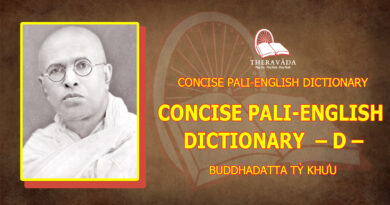JHANAS, CONCENTRATION, AND WISDOM
JHANAS, CONCENTRATION, AND WISDOM
Bhikkhu Thanissaro
Excerpted from: The Wings to Awakening , by Thanissaro Bhikkhu
Part III: The Basic Factors
F. Concentration and Discernment
We noted that some of the sets in the “Wings to Awakening list”, jhana as a condition for discernment, while others list discernment as a condition for jhana. Place both of these patterns into the context of this/that conditionality, and they convey the point that jhana and discernment in practice are mutually supporting. Passage §171 states this point explicitly, while §165 and §166 show that the difference between the two causal patterns relates to differences in meditators: some develop strong powers of concentration before developing strong discernment, whereas others gain a sound theoretical understanding of the Dhamma before developing strong concentration. In either case, both strong concentration and sound discernment are needed to bring about Awakening. Passage §111 makes the point that when the practice reaches the culmination of its development, concentration and discernment act in concert. The passages in this section deal with this topic in more detail.
The role of jhana as a condition for transcendent discernment is one of the most controversial issues in the Theravada tradition. Three basic positions have been advanced in modern writings. One, following the commentarial tradition, asserts that jhana is not necessary for any of the four levels of Awakening and that there is a class of individuals — called “dry insight” meditators — who are “released through discernment” based on a level of concentration lower than that of jhana. A second position, citing a passage in the Canon [A.III.88; MFU, pp. 103] stating that concentration is mastered only on the level of non-returning, holds that jhana is necessary for the attainment of non-returning and Arahantship, but not for the lower levels of Awakening. The third position states that the attainment of at least the first level of jhana is essential for all four levels of Awakening.
Evidence from the Canon supports the third position, but not the other two. As §106 points out, the attainment of stream-entry has eight factors, one of which is right concentration, defined as jhana. In fact, according to this particular discourse, jhana is the heart of the streamwinner’s path. Secondly, there is no passage in the Canon describing the development of transcendent discernment without at least some skill in jhana. The statement that concentration is mastered only on the level of non-returning must be interpreted in the light of the distinction between mastery and attainment. A streamwinner may have attained jhana without mastering it; the discernment developed in the process of gaining full mastery over the practice of jhana will then lead him/her to the level of non-returning. As for the term “released through discernment,” passage §168 shows that it denotes people who have become Arahants without experiencing the four formless jhanas. It does not indicate a person who has not experienced jhana.
Part of the controversy over this question may be explained by the fact that the commentarial literature defines jhana in terms that bear little resemblance to the canonical description. The Path of Purification — the cornerstone of the commentarial system — takes as its paradigm for meditation practice a method called kasina, in which one stares at an external object until the image of the object is imprinted in one’s mind. The image then gives rise to a countersign that is said to indicate the attainment of threshold concentration, a necessary prelude to jhana. The text then tries to fit all other meditation methods into the mold of kasina practice, so that they too give rise to countersigns, but even by its own admission, breath meditation does not fit well into the mold: with other methods, the stronger one’s focus, the more vivid the object and the closer it is to producing a sign and countersign; but with the breath, the stronger one’s focus, the harder the object is to detect. As a result, the text states that only Buddhas and Buddhas’ sons find the breath a congenial focal point for attaining jhana.
None of these assertions have any support in the Canon. Although a practice called kasina is mentioned tangentially in some of the discourses, the only point where it is described in any detail [M.121; MFU, pp. 82-85] makes no mention of staring at an object or gaining a countersign. If breath meditation were congenial only to Buddhas and their sons, there seems little reason for the Buddha to have taught it so frequently and to such a wide variety of people. If the arising of a countersign were essential to the attainment of jhana, one would expect it to be included in the steps of breath meditation and in the graphic analogies used to describe jhana, but it isn’t. Some Theravadins insist that questioning the commentaries is a sign of disrespect for the tradition, but it seems to be a sign of greater disrespect for the Buddha — or the compilers of the Canon — to assume that he or they would have left out something absolutely essential to the practice.
All of these points seem to indicate that what jhana means in the commentaries is something quite different from what it means in the Canon. Because of this difference we can say that the commentaries are right in viewing their type of jhana as unnecessary for Awakening, but Awakening cannot occur without the attainment of jhana in the canonical sense.
We have already given a sketch in the preceding section of how jhana in its canonical sense can act as the basis for transcendent discernment. To recapitulate: On attaining any of the first seven levels of jhana, one may step back slightly from the object of jhana — entering the fifth factor of noble right concentration [§150] — to perceive how the mind relates to the object. In doing this, one sees the process of causation as it plays a role in bringing the mind to jhana, together with the various mental acts of fabrication that go into keeping it there [§182]. Passage §172 lists these acts in considerable detail. The fact that the passage emphasizes the amazing abilities of Sariputta, the Buddha’s foremost disciple in terms of discernment, implies that there is no need for every meditator to perceive all these acts in such a detailed fashion. What is essential is that one develop a sense of dispassion for the state of jhana, seeing that even the relatively steady sense of refined pleasure and equanimity it provides is artificial and willed, inconstant and stressful [§182], a state fabricated from many different events, and thus not worth identifying with. Jhana thus becomes an ideal test case for understanding the workings of kamma and dependent co-arising in the mind. Its stability gives discernment a firm basis for seeing clearly; its refined sense of pleasure and equanimity allow the mind to realize that even the most refined mundane states involve the inconstancy and stress common to all willed phenomena. Passage §167 lists a number of verbal mental acts surrounding the exercise of supranormal powers that can be regarded in a similar light, as topics to be analyzed so as to give rise to a sense of dispassion. The dispassion that results in either case enables one to experience the fading away and cessation of the last remaining activities in the mind, even the activity of discernment itself. When this process fully matures, it leads on to total relinquishment, resulting in the clear knowing and release of Arahantship.
In contrast to the issue of the role of jhana as a condition for discernment, the role of discernment as a condition for jhana is uncontroversial. Discernment aids jhana on two levels: mundane and transcendent. On the mundane level, it enables one to perceive the various factors that go into one’s state of jhana so that one can master them and shed the factors that prevent one from attaining a higher level of jhana. This again involves the reflection that constitutes the fifth factor of noble right concentration, but in this case the results stay on the mundane level. For instance, as one masters the first level of jhana and can reflect on the elements of stress it contains, one may perceive that directed thought and evaluation should be abandoned because they have become unnecessary in maintaining one’s concentration, just as the forms used in pouring a cement wall become unnecessary when the cement has hardened. In dropping these factors, one then goes on to the second level of jhana. Passage §175 gives a list of the factors that, in succession, are dropped in this way as one attains higher and higher levels of concentration.
On the transcendent level, the discernment that precipitates Awakening results in a supramundane level of jhana called the fruit of gnosis, which is described in §§176-77 — a type of jhana independent of all perceptions (mental labels) and intentional processes, beyond all limitations of cosmos, time, and the present: the Arahant’s foretaste, in this lifetime, of the absolutely total Unbinding experienced by the awakened mind at death.







